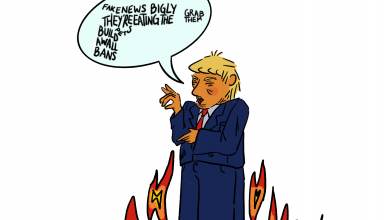As the Den of Lions Stirs Awake, India’s Descent Begins

Image via Tribune India, Vibha Sharma
Image Description: An elderly woman stands with her fist raised high and her other hand holding a long flag that is yellow and green, representative of the protest struggle. Many other elderly and young woman sit and stand behind her in a large crowd raising their fists and flags in solidarity. They are all wearing many different colors and styles of the typical Punjabi suit.
The Indian Government passed three laws in September 2020 that have caused the largest protest in human history to materialize. Currently, many of India’s farmers face enormous debt. With these new laws, farmers will be forced to sell their crops to private corporations who will pay them far less than the market price, increasing farmer debt and causing the epidemic of farmer suicide to continue. Additionally, the new laws make it so that farmers cannot fight against, go to court, or take back their land if seized by debt collectors or the government.
Upwards of 250 million people are protesting –– more than 75% of the United States’ entire population. Many farmers have left their lands and homes to march by foot to Delhi (India’s capital) to raise awareness and protest against the Neo-Nazi leader of the country, Narendra Modi, whose tyrannical reign has only brutalized and beat India’s minorities, primarily Sikhs and Muslims. However, Sikhs are far from being victims to this struggle; suppressed for the last 36 years after the Sikh genocide, this community of lions has now stirred awake ready to fight against the years of targeted genocidal extinction of their history and culture brought about by neo-nazi Hindu regimes.
With a population of over 1 billion, it makes sense that agriculture is India’s most significant industry and a source of livelihood for 58% of its people. Punjab, a state in Northern India, produces more than 10% of India’s most consumed and traded crops: wheat and rice. Punjab has been historically documented as having fertile and rich soil as its five rivers carry minerals, depositing them into the agricultural plains. However, over 75% of Punjab’s water is diverted to Pakistan and other states illegally. A loss of water has led to tube-well irrigation, which depletes groundwater at high rates, exacerbating many health issues and creating a causal effect of increasing toxic agricultural chemicals and uranium in Punjab’s environment.
Punjab’s farmers have been hit the hardest, suffering from carcinogens they’ve now been forcibly exposed to, struggling with crop shortage, and taking on extra debt to continue producing their crops at the high rates demanded. These laws only worsen their plight, forcing Punjab’s farmers, over 60% of whom are Sikh, at the forefront of this protest, especially women and elders.
The relationship between Sikhs and farming is a strong one. Most of India’s Sikhs are farmers, and those who have immigrated to first-world countries have traditionally kept in-line with some form of agricultural work. For example, in the United States, Sikh-American farmers are integral to the agricultural industry and have started to dominate the trucking industry.
Sikh immigrants bow their heads to the land of the five rivers, Punjab, which taught them the secrets of farming and kept their history alive and breathing. The critical need for Sikh sovereignty has been ignored by the world, especially by the current tyrannical regime in India. In 1973, the Sikh political party compiled the Anandpur Resolution, a list of demands for the Indian Government, which strived to make Punjab under control of the central Sikh political institution, the Akal Takht, as opposed to the Indian Government, which is known for suppressing Sikh sovereignty. Another point in the Anandpur Resolution was to support Punjab’s economy, especially farmers. The Indian Government and Prime Minister Indira Gandhi rejected these demands.
The Sikh leader at the time, Sant Jarnail Singh Ji Bhindranwale, had formed a rival power structure in the face of the Indian Government. The resources that the Indian Government failed to provide due to their corruption, Sant Ji was able to provide. Instead of seeking support from local police and the justice system, many of India’s people came to the steps of Darbar Sahib in Amritsar, Punjab, India, to seek support for their troubles from Sant Ji.
Indira Gandhi, the Prime Minister of India at that time, terrified of the growing independent Sikh sovereignty and the support Sant Ji was getting from many of India’s citizens, labeled Sant Ji and the Sikhs as anti-nationalists and terrorists. In June of 1984, on an important religious holiday when Sikhs from all over India had gathered at Darbar Sahib, the Indian Government opened fire on the Sikhs inside, barricading them without any chance to escape. This systematic and organized genocide that continued until the end of the year was known as Operation Bluestar.
Witnesses watched with horror as the mobs walked the streets of New Delhi, gang-raping Sikh women, murdering Sikh men, and burning down Sikh homes, businesses, and Gurdwaras (Sikh houses of worship). Sikh mens’ beards and hair were cut, while tires were thrown around their necks and lit aflame. Eyewitness accounts describe how law enforcement and government officials participated in the massacres by engaging in the violence, inciting civilians to seek vengeance, and providing the mobs with weapons.
With such disarray, an eerie calm settled over India. Though the country was silent, the land of Punjab continued to scream and plead: its soil now leaving red and brown stains on the hands of farmers, its crops trampled over with skid marks from tanks, its air all metallic, and its houses with black and red x’s on the doors for Sikh families. All files and records from the planning on Operation Bluestar have been redacted, censored, or conveniently “lost.” Family members are still “missing.” Urns remain empty, pleading that maybe one day at least the ashes will be able to find a place in them instead of soulless hope.
For over 36 years, justice has still not prevailed –– the same plea to the Creator of many oppressed minorities across many countries. Widows, mothers, and sisters sit in beat-down shacks in Tilak Nagar (Widow’s Colony), the city in Delhi where India’s scars of carnage lie. Each household keeps pictures of their lost ones, while tears seem to run without pause and perturbed screams ring in silence. Pictures of their sons, husbands, fathers, and children, who faced the true violent spirit behind India’s boiling pot of home-grown extremists they witnessed first-hand, hang on every wall.
Today, the Kissan Morcha (Farmer’s protest) movement in Delhi has been labeled as the biggest revolution in history, and it is because Sikhs, the Indigenous people of Punjab, have been holding it in for years –– the land of the fiver rivers has been holding in the injustice by the Indian Government for years. This Morcha (meaning protest in Punjabi) has been ongoing for over five months, passing the Punjabi holiday of Lohri (January 13) –– a day for rejoicing and celebrating the crops, the land, and the harvest. Despite these immense challenges, Punjab’s farmers have displayed the true meaning of absolute Chardikala (a Sikh word meaning eternal and ever-rising optimism) as they build their community back up from the loss of spirituality once taken from them. They have opened libraries at each site, created a newspaper that relays the critical voice of the farmers’ struggle (Trolley Times), opened prayer locations and gatherings, and provided stages for daily inspirational speeches. Lastly, they have used a style of traditional folk singing in Punjabi, known as bolis, as a form of resilience against the injustice upon them.
Furthermore, Delhi residents have cited that Delhi has never been more well-resourced, well-fed, and well-educated as Sikh farmers have started to provide their labor to help others in the area. Some of the services offered are free schooling from protestors with Bachelor’s and Ph.D.’s, free food more than three times a day, free libraries, free healthcare, free clothes, free gyms, and free menstrual products. Punjab’s Sikhs have provided one of the most wealthy cities in all of India with resources that have helped millions of people living locally. Meanwhile, the Indian Government has never offered this level of support for its citizens since their focus solely remains on furthering a Hindu-only nation. Still, Indian media has labeled Sikhs as terrorists and anti-nationalists to remove the spotlights off their own fascist crimes. They’ve stooped as low as to claim that that farmers who are making pizza, from ingredients they’ve broken their backs to farm, are being anti-nationalist. Khalsa Aid (an international NGO to provide humanitarian aid in disaster areas and civil conflict zones around the world) has been labeled as having parallels to KKK and the Nazis because they provided farmers with food, shelter, water, and foot massagers –– a luxury that Punjab’s farmers have never enjoyed nor would have ever been able to, despite traveling thousands of miles from Punjab to Delhi.
Besides media sensationalization, the RSS, a neo-nazi extremist group hell-bent on creating a Hindu-only nation, has done its best to eradicate Sikhs. There have been many reports of Sikh places of worship destroyed, vandalized, and rebuilt to eliminate their history. The Sikhs’ language –– Punjabi and Gurmukhi –– have been put on the back-burner as legislation has forced Sikhs to prioritize English and Hindi in a nation with rich linguistic diversity. The RSS has also worked diligently to change Sikh history in textbooks.
On January 8, Punjab’s farmers met with the Indian Government and walked out of the meeting with a revolutionary statement: either we will die or we will win. Over 108 Sikhs have become shaheeds (martyrs) in the fight against fascism and capitalist greed. The question lingers: how many more Sikhs will need to die of cold and starvation through protesting before the Indian government bats an eye?
It remains a very real fear that in any of the coming days, Prime Minister Narendra Modi will utilize his history of systematically executing minorities by calling upon the Indian military and his friends in the RSS to push through an agenda of another genocide. As Indian Media continues to disenfranchise farmers, Modi may use it as an excuse to incite violence against them –– an act purposefully orchestrated to eradicate Sikhs; however, he may end up harming the remaining minority of farmers who are Hindus and Muslims as well.
After the rightful assassination of Indira Gandhi, Rajiv Gandhi (her son) retaliated, “When a big tree falls, the earth shakes,” in support of the systematic killings of Sikhs in 1984. After the anti-Muslim riots in 2002, the current Prime Minister of India, Narendra Modi, justified the massacre by saying, “Every action has an equal and opposite reaction.”
They and the Indian Government have continuously failed to realize that they can’t awaken a community of lions and expect not to get eaten.
The truth is always revolutionary.




